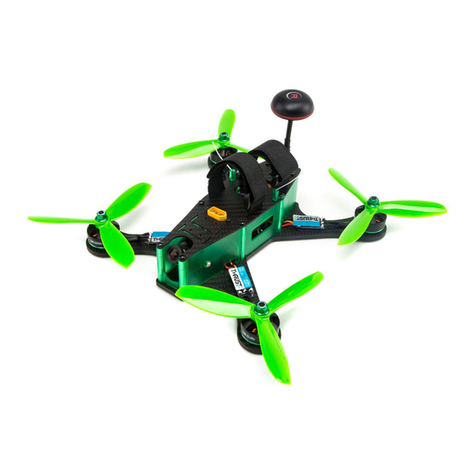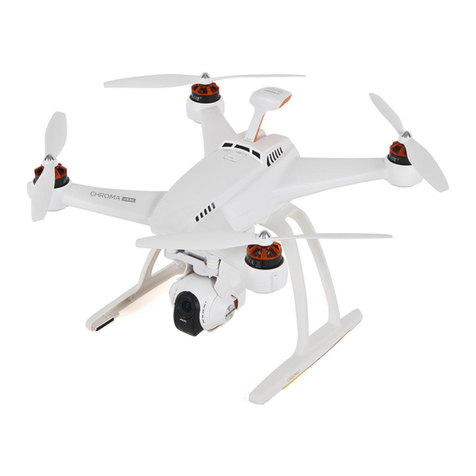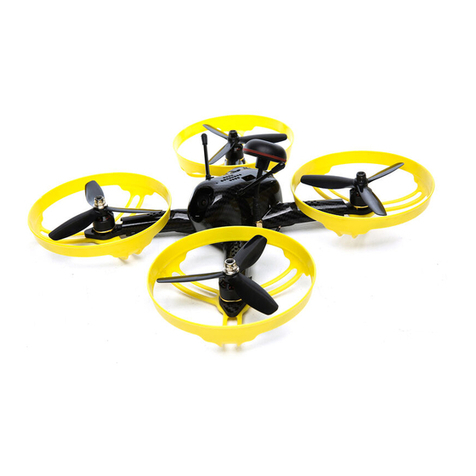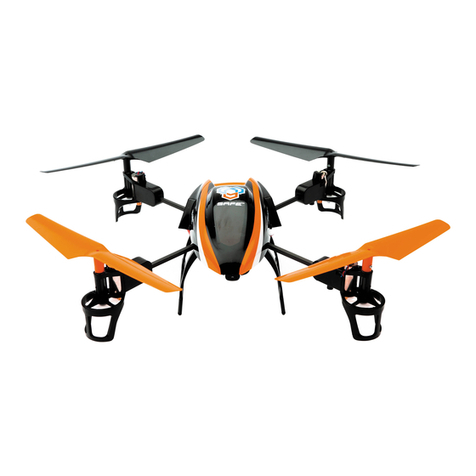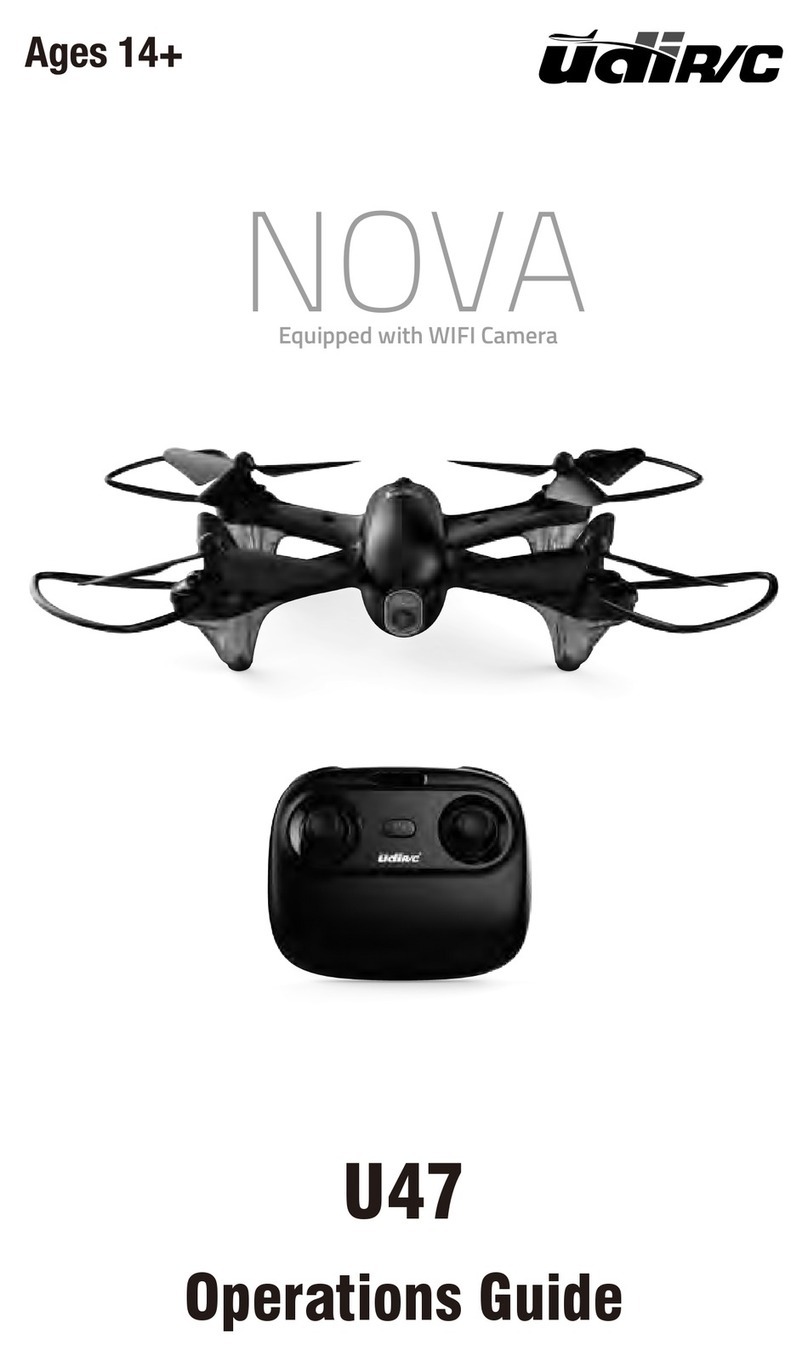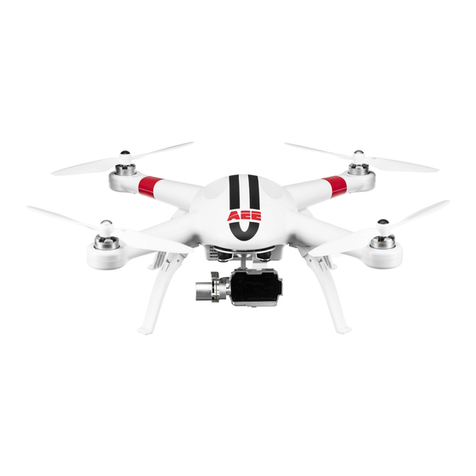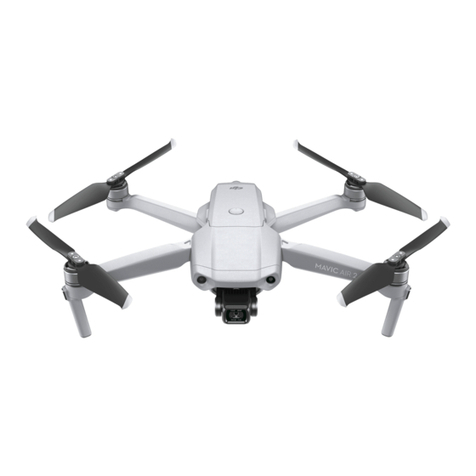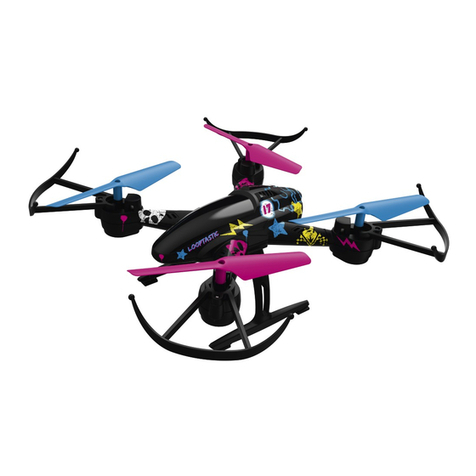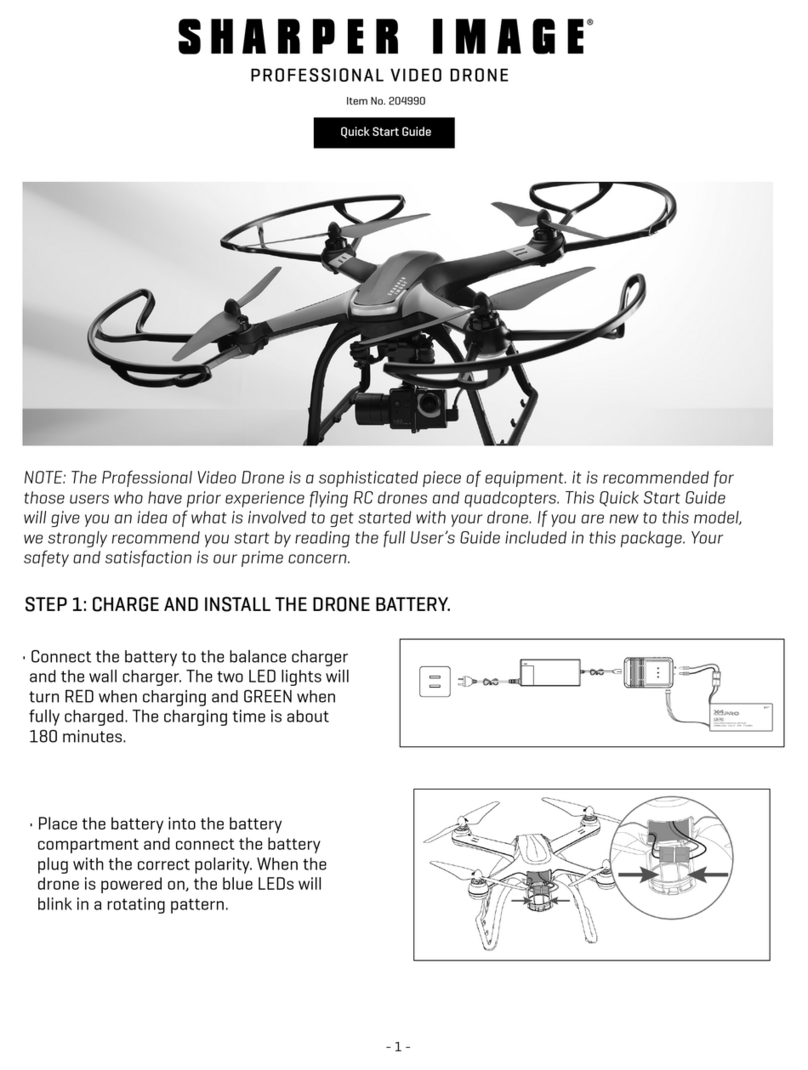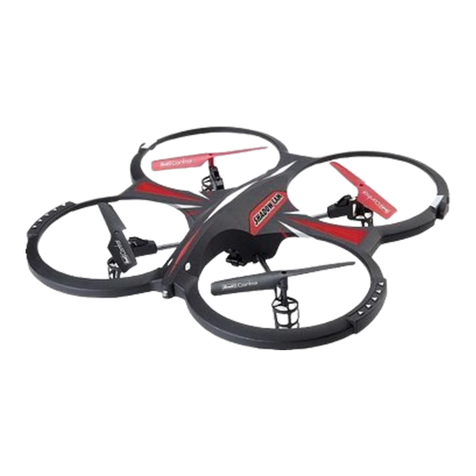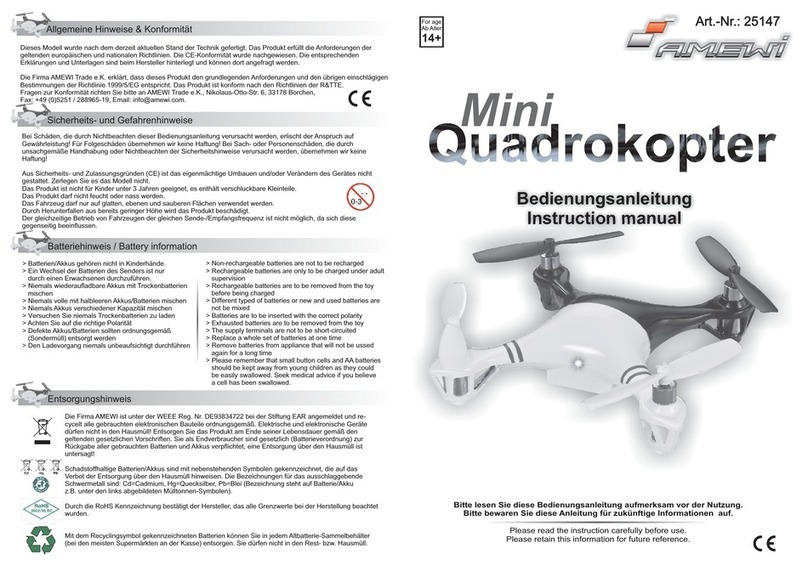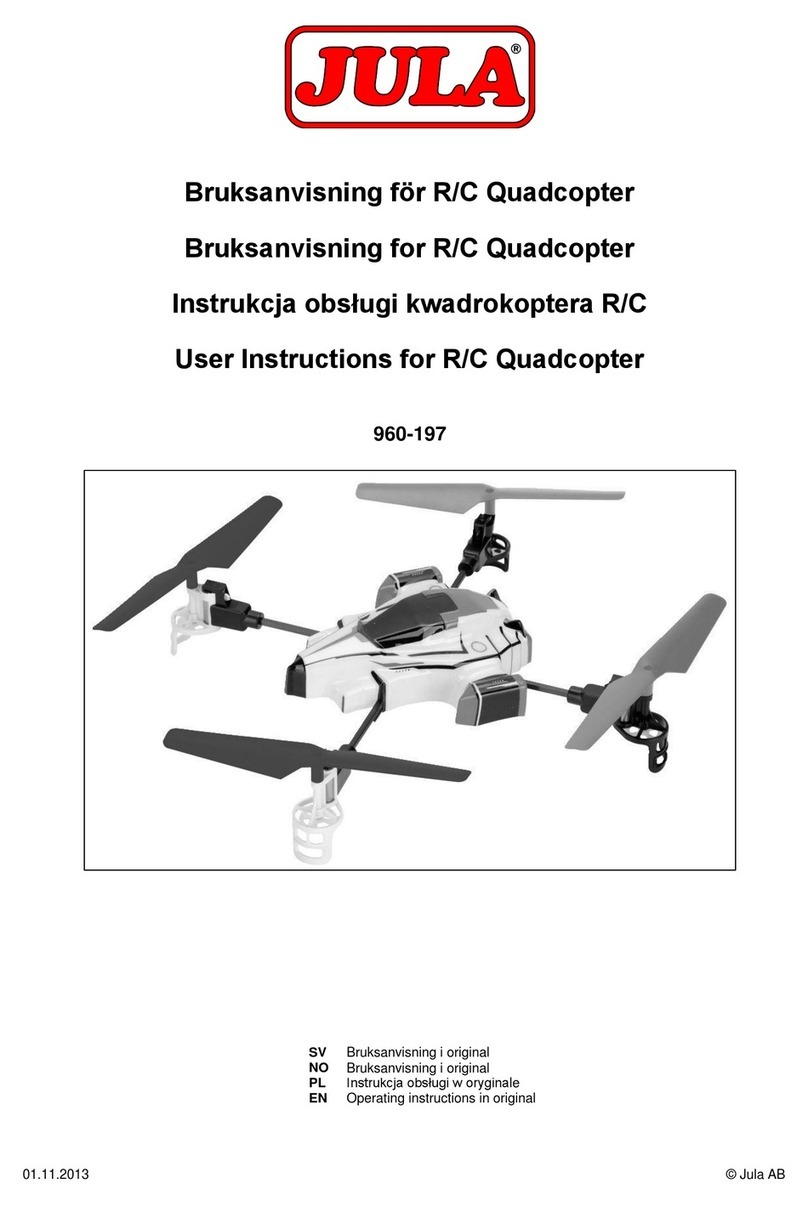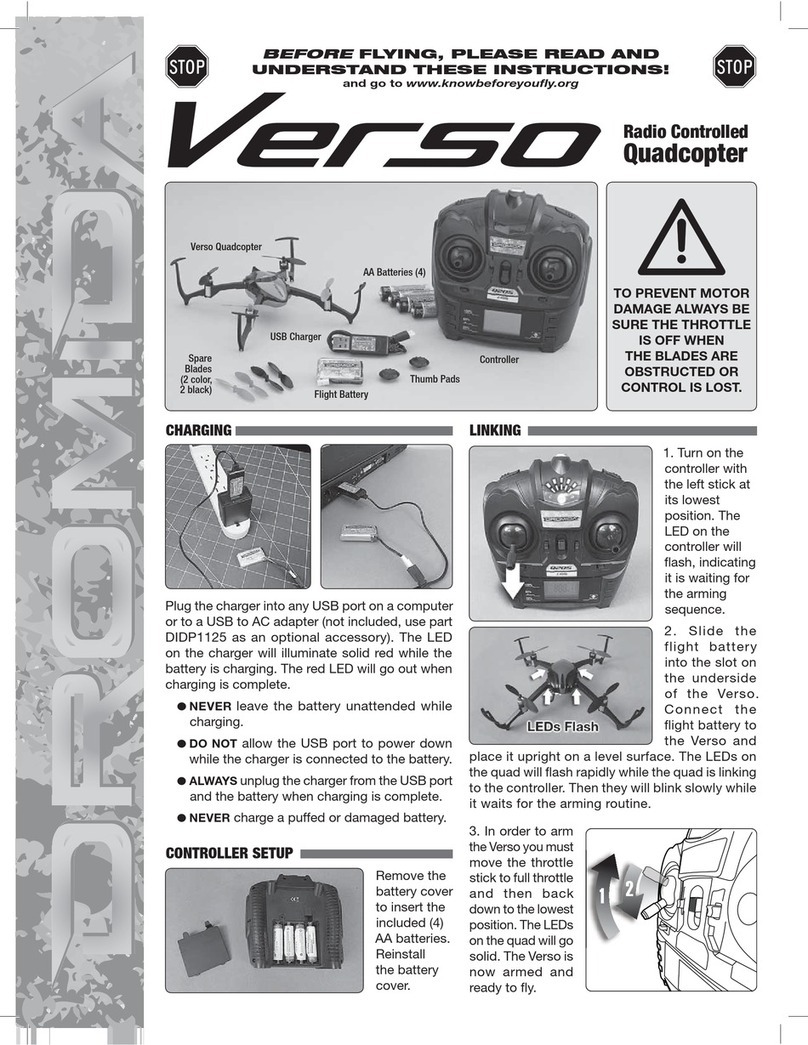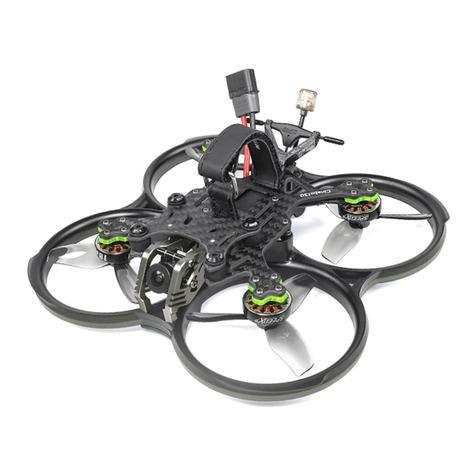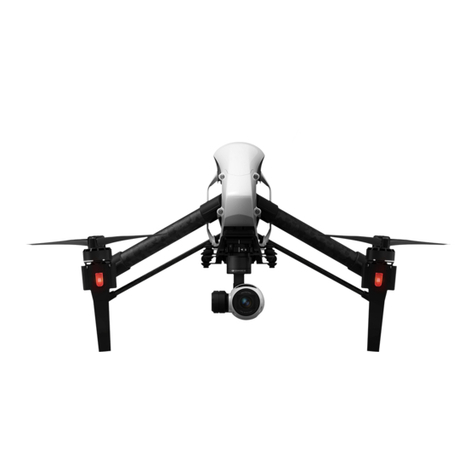Blade Nano QX2 FPV User manual


2
EN
WARNING: Read the ENTIRE instruction manual to become familiar with the features of the product before
operating. Failure to operate the product correctly can result in damage to the product, personal property and
cause serious injury.
This is a sophisticated hobby product. It must be operated with caution and common sense and requires some basic
mechanical ability. Failure to operate this Product in a safe and responsible manner could result in injury or damage
to the product or other property. This product is not intended for use by children without direct adult supervision. Do
not use with incompatible components or alter this product in any way outside of the instructions provided by Horizon
Hobby, LLC. This manual contains instructions for safety, operation and maintenance. It is essential to read and follow
all the instructions and warnings in the manual, prior to assembly, setup or use, in order to operate correctly and avoid
damage or serious injury.
The following terms are used throughout the product literature to indicate various levels of potential harm when
operating this product:
NOTICE: Procedures, which if not properly followed, create a possibility of physical property damage AND a little or no
possibility of injury.
CAUTION: Procedures, which if not properly followed, create the probability of physical property damage AND a
possibility of serious injury.
WARNING: Procedures, which if not properly followed, create the probability of property damage, collateral damage,
and serious injury OR create a high probability of superficial injury.
NOTICE
All instructions, warranties and other collateral documents are subject to change at the sole discretion of Horizon
Hobby, LLC. For up-to-date product literature, visit horizonhobby.com and click on the support tab for this product.
Meaning of Special Language
Age Recommendation: Not for children under 14 years. This is not a toy.

3EN
• Always keep a safe distance in all directions around
your model to avoid collisions or injury. This model is
controlled by a radio signal subject to interference from
many sources outside your control. Interference can
cause momentary loss of control.
• Always operate your model in open spaces away from
full-size vehicles, traffic and people.
• Always carefully follow the directions and warnings for
this and any optional support equipment
(chargers, rechargeable battery packs, etc.).
• Always keep all chemicals, small parts and anything
electrical out of the reach of children.
• Always avoid water exposure to all equipment not
specifically designed and protected for this purpose.
Moisture causes damage to electronics.
• Never place any portion of the model in your mouth as it
could cause serious injury or even death.
• Never operate your model with low transmitter batteries.
• Always keep aircraft in sight and under control.
• Always move the throttle fully down at rotor strike.
• Always use fully charged batteries.
• Always keep transmitter powered on while aircraft is
powered.
• Always remove batteries before disassembly.
• Always keep moving parts clean.
• Always keep parts dry.
• Always let parts cool after use before touching.
• Always remove batteries after use.
• Never operate aircraft with damaged wiring.
• Never touch moving parts.
Safety Precautions and Warnings
If you are operating this product in North America, you are required to have an Amateur Radio (HAM) license.
For information on obtaining an Amateur Radio license visit www.arrl.org.

4
EN
Table of Contents
Box Contents .................................................................... 5
First Flight Preparation ...................................................... 6
Flying Checklist................................................................. 6
Charging Warnings............................................................ 6
Battery Charging............................................................... 7
Transmitter Setup.............................................................. 8
Installing the Flight Battery ................................................ 9
Transmitter and Receiver Binding..................................... 10
SAFE®Technology........................................................... 10
Understanding the Primary Flight Controls ........................ 11
LED Codes...................................................................... 12
Flight Mode Selection......................................................12
Flying the Quadcopter ..................................................... 12
Using the Micro FPV Camera ........................................... 14
Post-Flight Inspection and Maintenance Checklist............. 15
Replacing the Propellers..................................................15
Replacing the Motors ...................................................... 16
Troubleshooting Guide..................................................... 16
Exploded View................................................................. 18
Parts Listings.................................................................. 19
Optional Parts................................................................. 19
Limited Warranty............................................................. 19
Warranty and Service Contact Information ........................ 21
FCC Statement ............................................................... 22
IC Information................................................................. 22
Compliance Information for the European Union................ 23
Length 5.1 in (130mm)
Width 5.1 in (130mm)
Height 1.9 in (50mm)
Propeller Diameter 2.3 in (60mm)
Flying Weight 1.8 oz (52 g)
Specifications
To receive product updates, special offers and more, register your product at www.bladehelis.com

5EN
Box Contents
• Blade®Nano QX2 FPV Quadcopter
• 25mW Micro Camera System
• 500mAh 1S 3.7V 25C LiPo
• 1S USB Li-Po Charger, 500mAh High Current UMX Connector

6
EN
CAUTION: All instructions and warnings must be
followed exactly. Mishandling of Li-Po batteries can
result in a fire, personal injury and/or property damage.
• NEVER LEAVE CHARGING BATTERIES UNATTENDED.
• NEVER CHARGE BATTERIES OVERNIGHT.
• By handling, charging or using the included Li-Po battery,
you assume all risks associated with lithium batteries.
• If at any time the battery begins to balloon or swell,
discontinue use immediately. If charging or discharging,
discontinue and disconnect. Continuing to use, charge
or discharge a battery that is ballooning or swelling can
result in fire.
• Always store the battery at room temperature in a dry
area for best results.
• Always transport or temporarily store the battery in a
temperature range of 40–120º F (5–49° C).
• Do not store battery or model in a car or direct sunlight.
If stored in a hot car, the battery can be damaged or
even catch fire.
• Always charge batteries away from flammable materials.
• Always inspect the battery before charging.
• Always disconnect the battery after charging, and let the
charger cool between charges.
• Always constantly monitor the temperature of the battery
pack while charging.
• ONLY USE A CHARGER SPECIFICALLY DESIGNED TO
CHARGE LI-PO BATTERIES. Failure to charge the battery
with a compatible charger may cause a fire resulting in
personal injury and/or property damage.
• Never discharge Li-Po cells to below 3V under load.
• Never cover warning labels with hook and loop strips.
• Never charge batteries outside recommended levels.
• Never charge damaged batteries.
• Never attempt to dismantle or alter the charger.
• Never allow minors to charge battery packs.
• Never charge batteries in extremely hot or cold places
(recommended between 40–120° F or (5–49° C) or place
in direct sunlight.
Charging Warnings
First Flight Preparation
• Remove and inspect contents
• Begin charging the flight battery
• Install the flight battery in the quadcopter
(once it has been fully charged)
• Program your computer transmitter
• Bind your transmitter
• Familiarize yourself with the controls
• Find a suitable area for flying
Flying Checklist
❏Always turn the transmitter on first
❏Plug the flight battery into the lead from the 4-in-1
control unit
❏Allow the 4-in-1 control unit to initialize and arm properly
❏Fly the model
❏Land the model
❏Unplug the flight battery from the 4-in-1 control unit
❏Always turn the transmitter off last

7EN
Battery Charging
CAUTION: Only use chargers specifically designed to charge the included Li-Po battery.
Failure to do so could result in fire, causing injury or property damage.
CAUTION: Never exceed the recommended charge rate.
The Battery Charger (EFLC1013) included with your quadcopter has been designed to safely charge the 1S 3.7V 500mAh 25C
Li-Po flight battery. Refer to the charging warnings. It is recommended to charge the battery pack while you are inspecting
the aircraft. The flight battery will be required to confirm proper aircraft operation in future steps.
NOTICE: Inspect the battery to make sure it is not damaged e.g., swollen, bent, broken or punctured.
Charge only batteries that are cool to the touch and are not damaged.
1. Insert the charger into a USB port. The charger
only uses power from the USB port. USB power
supplies, such as those used to charge cellular
phones, can also be used.
2. Connect the battery to the charger as shown in the illustration above. When you make the connection successfully, the
LED on the charger turns solid red, indicating charging has begun. Charging a fully discharged (not over-discharged)
500mAh battery takes approximately 60 minutes. The LED goes out when the charge is complete.
CHARGING (Solid Red LED)
MAX CHARGE (LED OFF )
3. Always disconnect the flight battery from the charger immediately upon completion of charging.
CAUTION: Once charging is complete, immediately remove the battery. Never leave a battery connected to the charger.
USB Li-Po
Charger
1S 3.7V 500 mAh
EFLB5001S25UM
EFLC1013
SOLID RED LED
–Charging
DC Input:5.0V 500mA
DC Output:4.2V 500mA
LED OFF
–Charge
Complete

8
EN
Transmitter Setup
Transmiter "Model
Type" Stability to
Agility TX Setup Stability to
Agility Switch Dual Rate
Switch High
Rate Low
Rate
DX6i Acro In FLAPS Menu:
Set NORM FLAP to Down 20
Cycle Flaps Pos first time
0-1, each time after 1-0-1 ELEV-AIL D/R 100% 70%
DX7S, DX8 Acro In Switch Select Menu: Set Flap to
Inh, Set Trainer to Aux1 Press Trainer/Bind ELEV-AIL D/R 100% 70%
DX6, DX7 (Gen 2),
DX9, DX18
Acro In Channel Assign Menu Go to Next:
Set 6 AUX1: to I Press Trainer/Bind ELEV-AIL D/R 100% 70%
30% exponential on aileron and elevator is recommended if it is available on your chosen transmitter.
DXe users:
Use the default model settings. Press and release the bind/panic/trainer button to cycle between the flight modes.

9EN
1. Lower the throttle to the lowest setting and center all trims.
2. Power ON the transmitter.
3. Insert the battery as shown.
4. Connect the battery cable to the 4-in-1 control unit.
CAUTION: Connecting the battery to the control board with reversed polarity will cause damage to the control
board, the battery or both. Damage caused by incorrectly connecting the battery is not covered under warranty.
5. Place the quadcopter upright on a flat surface. Do not move the quadcopter until the LED on the 4-in-1 control unit is solid
blue (not blinking). If the LED continues to rapidly flash blue, refer to the Transmitter and Receiver Binding section.
CAUTION: Always disconnect the Li-Po battery from the aircraft when not flying to avoid over-discharging
the battery. Batteries discharged to a voltage lower than the lowest approved voltage may become damaged,
resulting in loss of performance and potential fire when the batteries are charged.
Installing the Flight Battery

10
EN
Transmitter and Receiver Binding
To bind or re-bind your aircraft to your chosen transmitter, please follow the directions below.
General Binding Procedure
1.Disconnect the flight battery from the quadcopter.
2.Center all trims on your transmitter.
3.Power off the transmitter and fully lower the throttle.
4.Connect the flight battery in the quadcopter.The blue LED on the 4-in-1 control unit flashes rapidly, indicating it is in bind mode.
5.Put the transmitter into bind mode while powering on the transmitter.
6.Release the bind button/switch after 2–3 seconds.The quadcopter is bound when the blue LED on the 4-in-1 control unit turns solid.
7.Disconnect the flight battery and power the transmitter off.
Revolutionary SAFE®(Sensor Assisted Flight Envelope) technology uses an innovative combination of multi-axis sensors and
software that allows model aircraft to know its position relative to the horizon. This spatial awareness is utilized to create
a controlled flight envelope the aircraft uses to maintain a safe region of bank and pitch angles so you can fly more safely.
Far beyond stability, this level of protection offers multiple modes so the pilot can choose to develop his or her skills with a
greater degree of security and flight control that always feels crisp and responsive.
SAFE technology delivers:
• Flight envelope protection you can enable at the flip of a switch.
• Multiple modes to let you adapt SAFE technology to your skill level instantly.
Best of all, sophisticated SAFE technology doesn’t require any work to enjoy. Every aircraft with SAFE technology is ready to
use and optimized to offer the best possible flight experience.
FlySAFERC.com
Technology
If you encounter problems, obey binding instructions and refer to the troubleshooting guide for other instructions. If needed, contact
the appropriate Horizon Product Support office. For a list of compatible DSM®transmitters, please visit www.bindnfly.com.

11 EN
Elevator
Forward
Elevator down Elevator up Backward
Side View Side View
Rudder
Rudder left Rudder right
Understanding the Primary Flight Controls
If you are not familiar with the controls of your Nano QX2 FPV quadcopter, take a few minutes to familiarize yourself with
them before attempting your first flight.
Throttle
Throttle down
Throttle up
Side View Side View
Descend
Climb
Nose Yaws RightNose Yaws Left

12
EN
Aileron
Aileron left Left Aileron right Right
Rear View
LED Codes
Equipment LED Color LED Status Operation
Quadcopter
Off Off Loss of transmitter signal
Blue Rapid Blink Bind Mode
Solid Stability Mode
Red Solid Agility Mode
Blink Low Battery
Refer to the Transmitter Setup section for transmitter switch selection and specific setup information.
• Stability mode (quadcopter LED blue): the bank angle is limited. When the sticks are released, the quadcopter will
return to level flight.
• Agility mode (quadcopter LED red): the quadcopter has no bank angle limits and will not return to level fight if the
sticks are released. Use rates and expo to tune the performance according to your flying style.
Flight Mode Selection
Rear View
Consult your local laws and ordinances before choosing a location to fly your aircraft.
We recommend flying your aircraft outside in calm winds (less than 5 mph) or inside a large gymnasium. Always avoid
flying near houses, trees, wires and buildings. You should also be careful to avoid flying in areas where there are many
people, such as busy parks, schoolyards or soccer fields.
Flying the Quadcopter

13 EN
Takeo
Increase the throttle until the model is approximately 2 ft. (600mm) off the ground in a low-level hover and concentrate
on balancing the throttle stick’s position so that the quadcopter holds a steady hover altitude. In some cases, you may
need to make a few short “hops” to an altitude of just a few inches until you become familiar with the control inputs and
trim settings required to maintain a steady hover and altitude.
Hovering
The Nano QX2 FPV quadcopter requires minor throttle adjustments to maintain its altitude in hover. Remember to keep these
throttle adjustments as minimal as possible. Large adjustments could result in a loss of control and/or a possible crash.
While attempting to establish a low-level hover, check to see if any trim adjustments are required to help keep the
quadcopter from constantly drifting in various directions. If you find that it constantly drifts without any directional control
input, land the model before making any adjustments to the trim settings.
• If the nose of the quadcopter rotates to the left or right, adjust the rudder trim.
• If the quadcopter continually drifts forward or backward, adjust the elevator trim.
• If the quadcopter continually drifts to the left or right, adjust the aileron trim.
Continue making minor trim adjustments until the machine hovers at a low altitude with very little drifting and directional
control input. If this is your first multicopter or helicopter, seek the help of an experienced pilot to trim the model for you
before making your first flight.
With your quadcopter properly trimmed and maintaining a stable low-level hover, practice using the rudder, elevator and
aileron controls to familiarize yourself with the machine’s responses to control inputs. Remember to keep the control
inputs as minimal as possible.
NOTICE: Crash damage is not covered under warranty.
Low Voltage Cuto (LVC)
Once the battery reaches 3V under load, the ESC will continuously lower power supplied to the motor until complete
shutdown occurs. This helps prevent over-discharge of the Li-Po battery. Land immediately once the ESC activates LVC.
Continuing to fly after LVC can damage the battery, cause a crash, or both. Crash damage and batteries damaged due to
over-discharge are not covered under warranty.
NOTICE: Repeated flying to LVC will damage the battery.
Flight time with a fully charged battery is approximately 3-5 minutes, depending on how aggressively the quadcopter is flown.
LVC does not prevent the battery from over-discharge during storage.
Landing
To land, slowly decrease the throttle while in a low-level hover. After landing, lower the throttle completely to stop the
motors. Disconnect and remove the battery from the quadcopter to prevent over discharge. During storage, make sure the
battery charge does not fall below 3V per cell.

14
EN
Consult local laws and ordinances before operating FPV
equipment. In some areas, FPV operation may be limited or
prohibited. You are responsible for operating this product in
a legal and responsible manner.
1. Power on your radio transmitter, then power on the
aircraft.
2. Power on the video receiver to make sure the channel
is clear.
3. Select the desired video transmitter channel by press-
ing the button on the quadcopter to scroll through the
available channels, 1-7, as shown.
4. Adjust the vertical camera angle by rotating the camera
up or down prior to flight.
5. Perform a range test before flying.
If you experience static in the video feed, select a different
channel.
NOTICE: The 25mW micro video camera range on your
quadcopter is less than your flight control transmitter
range. Ensure you have adequate video camera range
for filming.
Tip: If you are flying with an FPV headset and are prone to
motion sickness, sit in a chair. If you start to suffer from
motion sickness while flying, lower your chin against your
chest.
Fly in open areas, away from people, trees, cars, and
buildings. The range of the system can be impacted by any
obstructions blocking your signal. It is normal to see break
up in the video going behind trees and other obstacles.
Avoid flying in the same general area as 5.8 GHz WiFi
sources as this may seriously degrade the range of the FPV
system.
Ultra Micro FPV Camera
Transmitter Channels
Channel 1 5740 MHz
Channel 2 5760 MHz
Channel 3 5780 MHz
Channel 4 5800 MHz
Channel 5 5820 MHz
Channel 6 5840 MHz
Channel 7 5860 MHz
Using the Micro FPV Camera
These frequencies are compatible with Band F, Fatshark,
Immersion RC and Airwave video receiver products

15 EN
Use the directions below to replace any
propeller that becomes damaged:
1. Check tip angle of the propeller
blades as shown.
2. Refer to the propeller rotation diagram
to determine which propeller should
be used.
3. Pull the damaged propeller off the
motor shaft.
4. Slide the appropriate new propeller
onto the motor shaft.
If the quadcopter crashes immediately
upon increasing the throttle, confirm the
propellers are located correctly.
Post-Flight Inspection and Maintenance Checklist
Replacing the Propellers
√
Cleaning
Make sure the battery is not connected before cleaning. Remove dust and debris with a soft brush or a dry, lint-free cloth.
Motors Replace the motor when the model will not fly steady or veers off when doing a climb out.
Wiring Make sure the wiring does not block moving parts. Replace damaged wiring and loose connectors.
Fasteners Make sure there are no loose screws, other fasteners or connectors. Do not over-tighten metal screws in
plastic parts. Tighten screws so the parts are mated together, then turn screw only 1/8th of a turn more.
Propellers Make sure there is no damage to the propellers or other parts that move at high speed. Damage to these parts
includes cracks, burrs, chips or scratches. Replace damaged parts before flying.
Clockwise Counter-
clockwise
Clockwise Counter-
clockwise
Blade tip angle Propeller rotation

16
EN
The motor rotation direction can be
determined by the color of the wire
leads. The clockwise motors have black
and white leads. The counter-clockwise
motors have red and blue leads.
1. Refer to the propeller rotation
diagram in the Replacing the Pro-
pellers section. Determine which
motor needs to be replaced and
which direction it rotates.
2. Unplug the motor wire from the
4-in-1 board.
3. Using your thumbs, carefully spread the base of the motor pod apart while pushing the motor downward out of the
pod as shown.
4. Slide the new motor into the pod until it is captured by the bottom of the motor pod.
5. Route the wire lead through the arm of the frame and plug the connector into the 4-in-1 board. Make sure to clip the
wire into the frame arm to keep the wire from interfering with the spinning propeller.
Troubleshooting Guide
Problem Possible Cause Solution
Control response is inconsistent
or requires extra trim to neutralize
movement
Aircraft not initialized on a level surface Disconnect the flight battery, center the control trim
and re-initialize the quadcopter
Battery not correctly placed in
battery slot Adjust battery position so quadcopter balances in
the center of the frame
Will not respond to throttle
Throttle too high and/or throttle trim is too
high Reset controls with the throttle stick and throttle
trim at the lowest setting
Quadcopter moved during initialization Disconnect the flight battery and re-initialize the
quadcopter while keeping it from moving
Throttle channel is reversed Disconnect flight battery, reverse the throttle chan-
nel on the transmitter, recconnect flight battery
Does not function and smells burnt
after connecting the flight battery Flight battery connected with the wrong
polarity Replace the 4-in-1 board. Connect the flight
battery noting proper polarity
Replacing the Motors

17 EN
Problem Possible Cause Solution
Reduced flight time
or is underpowered
Flight battery charge is low Completely recharge the flight battery
Inadequate power to flight battery charger Use a different USB power source for the charger
Flight battery is damaged Replace the flight battery and follow the flight
battery instructions
Flight conditions might be too cold Make sure the battery is warm (room temperature)
before use
One or more propellers are fouled Clean any pet hair, lint or grass away from the base
of the propellers
LED on receiver flashes rapidly
and quadcopter will not respond
to transmitter (during binding)
Transmitter too near aircraft during binding
process
Power off the transmitter. Move the transmitter a
larger distance from the aircraft. Disconnect and
reconnect the flight battery to the aircraft. Follow
the binding instructions
Bind switch or button was not held while
transmitter was powered on Power off transmitter and repeat bind process
Aircraft or transmitter is too close to large
metal object, wireless source or another
transmitter
Move aircraft and transmitter to another location
and attempt binding again
LED on the receiver flashes
rapidly and the quadcopter will
not respond to the transmitter
(after binding)
Less than a 5-second wait between first
powering on the transmitter and connecting
the flight battery to the quadcopter
Leave the transmitter powered on. Disconnect and
reconnect the flight battery to the quadcopter
The quadcopter is bound to a different model
memory (ModelMatch™ transmitters only)
Select the correct model memory on the transmit-
ter. Disconnect and reconnect the flight battery to
the quadcopter
Flight battery or transmitter battery charge
is too low Replace or recharge batteries
Aircraft or transmitter is too close to
large metal object, wireless source or
another transmitter
Move aircraft and transmitter to another
location and attempt connecting again
Crashes immediately upon lift-off Propellers in wrong locations or incorrect
flight mode selected Make necessary adjustments
Static in FPV feed
Interference on chosen channel Change the video transmitter and receiver
channel per the Using the Micro Camera section
Flying too close to 5.8 GHz WiFi source Remove WiFi source or move to a different
flying area

18
EN
2
7
6
1
9
5
8
3
4
3
4
Exploded View

19 EN
Limited Warranty
What this Warranty Covers
Horizon Hobby, LLC, (Horizon) warrants to the original purchaser
that the product purchased (the “Product”) will be free from
defects in materials and workmanship at the date of purchase.
What is Not Covered
This warranty is not transferable and does not cover (i) cosmet-
ic damage, (ii) damage due to acts of God, accident, misuse,
abuse, negligence, commercial use, or due to improper use,
installation, operation or maintenance, (iii) modification of or to
any part of the Product, (iv) attempted service by anyone other
than a Horizon Hobby authorized service center, (v) Product not
purchased from an authorized Horizon dealer, (vi) Product not
compliant with applicable technical regulations, or (vii) use that
violates any applicable laws, rules, or regulations.
OTHER THAN THE EXPRESS WARRANTY ABOVE, HORIZON
MAKES NO OTHER WARRANTY OR REPRESENTATION, AND
HEREBY DISCLAIMS ANY AND ALL IMPLIED WARRANTIES,
INCLUDING, WITHOUT LIMITATION, THE IMPLIED WARRANTIES
OF NON-INFRINGEMENT, MERCHANTABILITY AND
FITNESS FOR A PARTICULAR PURPOSE. THE PURCHASER
ACKNOWLEDGES THAT THEY ALONE HAVE DETERMINED THAT
THE PRODUCT WILL SUITABLY MEET THE REQUIREMENTS OF
THE PURCHASER’S INTENDED USE.
Parts Listings
Part # Description
1 BLH9103 4-in-1 Control Unit
2 BLH9011 Camera Board
3 BLH2204 Clockwise Motor
4 BLH2205 Counter-Clockwise Motor
5 BLH2207 Main Frame
6 BLH9101 Canopy Body
Part # Description
7 BLH9007 Camera Mount
8 BLH9102 Prop Set
9 EFLB5001S25UM 500mAh 1S 3.7V 25C LiPo,
High Current UMX Connector
EFLC1013 1S USB Li-Po Charger,
500mAh High Current UMX
Part # Description
SPMVR2500 Focal™FPV Wireless Headset
SMVR1100 Teleporter V4 Video Headset with Head Tracking
DXe DSMX Transmitter Only
DX7s DSMX 7-Channel Transmitter Only
DX6 DSMX 6-Channel Transmitter Only
Part # Description
DX7 DSMX 7-Channel Transmitter Only
DX8 DSMX 8-Channel Transmitter Only
DX9 DSMX 9-Channel Transmitter Only
DX18 DSMX 18-Channel Transmitter Only
Optional Parts

20
EN
Purchaser’s Remedy
Horizon’s sole obligation and purchaser’s sole and exclusive
remedy shall be that Horizon will, at its option, either (i) service,
or (ii) replace, any Product determined by Horizon to be defec-
tive. Horizon reserves the right to inspect any and all Product(s)
involved in a warranty claim. Service or replacement decisions
are at the sole discretion of Horizon. Proof of purchase is
required for all warranty claims. SERVICE OR REPLACEMENT
AS PROVIDED UNDER THIS WARRANTY IS THE PURCHASER’S
SOLE AND EXCLUSIVE REMEDY.
Limitation of Liability
HORIZON SHALL NOT BE LIABLE FOR SPECIAL, INDIRECT,
INCIDENTAL OR CONSEQUENTIAL DAMAGES, LOSS OF
PROFITS OR PRODUCTION OR COMMERCIAL LOSS IN ANY
WAY, REGARDLESS OF WHETHER SUCH CLAIM IS BASED IN
CONTRACT, WARRANTY, TORT, NEGLIGENCE, STRICT LIABILITY
OR ANY OTHER THEORY OF LIABILITY, EVEN IF HORIZON HAS
BEEN ADVISED OF THE POSSIBILITY OF SUCH DAMAGES.
Further, in no event shall the liability of Horizon exceed the
individual price of the Product on which liability is asserted. As
Horizon has no control over use, setup, final assembly, modi-
fication or misuse, no liability shall be assumed nor accepted
for any resulting damage or injury. By the act of use, setup
or assembly, the user accepts all resulting liability. If you as
the purchaser or user are not prepared to accept the liability
associated with the use of the Product, purchaser is advised to
return the Product immediately in new and unused condition to
the place of purchase.
Law
These terms are governed by Illinois law (without regard to
conflict of law principals). This warranty gives you specific legal
rights, and you may also have other rights which vary from
state to state. Horizon reserves the right to change or modify
this warranty at any time without notice.
WARRANTY SERVICES
Questions, Assistance, and Services
Your local hobby store and/or place of purchase cannot provide
warranty support or service. Once assembly, setup or use of
the Product has been started, you must contact your local
distributor or Horizon directly. This will enable Horizon to better
answer your questions and service you in the event that you
may need any assistance. For questions or assistance, please
visit our website at www.horizonhobby.com, submit a Product
Support Inquiry, or call the toll free telephone number refer-
enced in the Warranty and Service Contact Information section
to speak with a Product Support representative.
Inspection or Services
If this Product needs to be inspected or serviced and is compli-
ant in the country you live and use the Product in, please use
the Horizon Online Service Request submission process found
on our website or call Horizon to obtain a Return Merchandise
Authorization (RMA) number. Pack the Product securely
using a shipping carton. Please note that original boxes may
be included, but are not designed to withstand the rigors of
shipping without additional protection. Ship via a carrier that
provides tracking and insurance for lost or damaged parcels,
as Horizon is not responsible for merchandise until it arrives
and is accepted at our facility. An Online Service Request is
available at http://www.horizonhobby.com/content/_service-
center_render-service-center. If you do not have internet
access, please contact Horizon Product Support to obtain
a RMA number along with instructions for submitting your
product for service. When calling Horizon, you will be asked
to provide your complete name, street address, email address
and phone number where you can be reached during business
hours. When sending product into Horizon, please include your
RMA number, a list of the included items, and a brief summary
of the problem. A copy of your original sales receipt must
be included for warranty consideration. Be sure your name,
address, and RMA number are clearly written on the outside of
the shipping carton.
NOTICE: Do not ship Li-Po batteries to Horizon. If you have
any issue with a Li-Po battery, please contact the appropriate
Horizon Product Support office.
Warranty Requirements
For Warranty consideration, you must include your origi-
nal sales receipt verifying the proof-of-purchase date.
Provided warranty conditions have been met, your Product will
be serviced or replaced free of charge. Service or replacement
decisions are at the sole discretion of Horizon.
Table of contents
Other Blade Quadcopter manuals
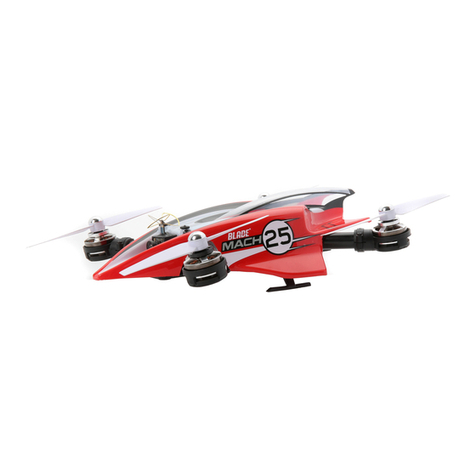
Blade
Blade Mach 25 User manual

Blade
Blade InducTrix 200 User manual
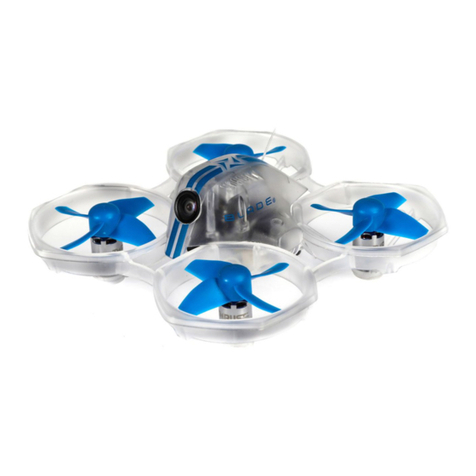
Blade
Blade Inductrix FPV BL BNF Basic User manual

Blade
Blade 180 QX HD User manual

Blade
Blade NANO QX User manual

Blade
Blade OZONE RTF BLH9700 User manual
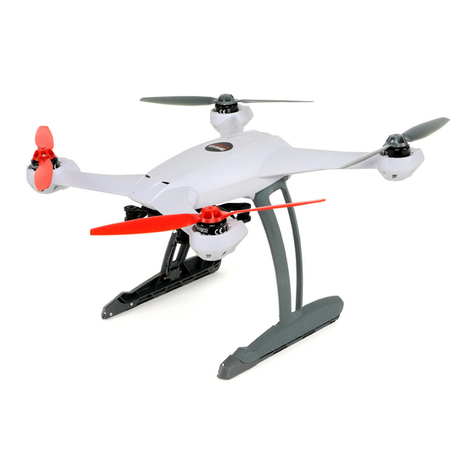
Blade
Blade Blade 350 QX2 AP Combo User manual

Blade
Blade 350 QX User manual
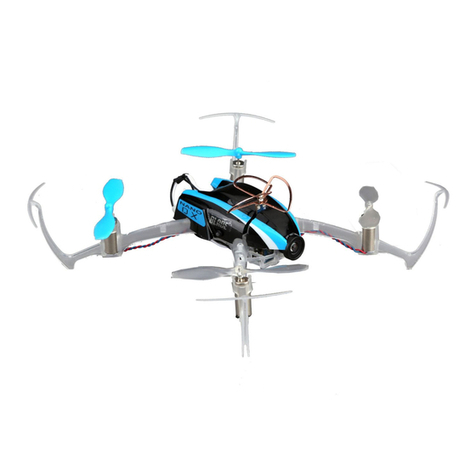
Blade
Blade FPV Nano QX User manual
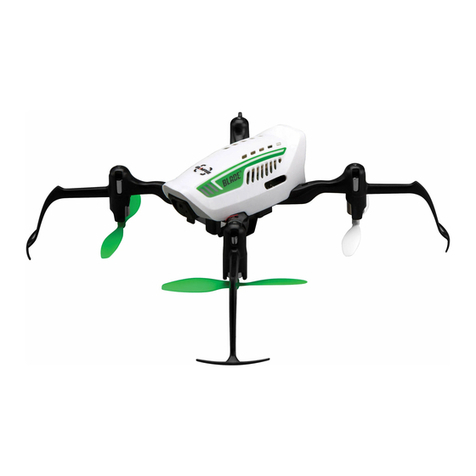
Blade
Blade Glimpse BNF BLH2280 User manual
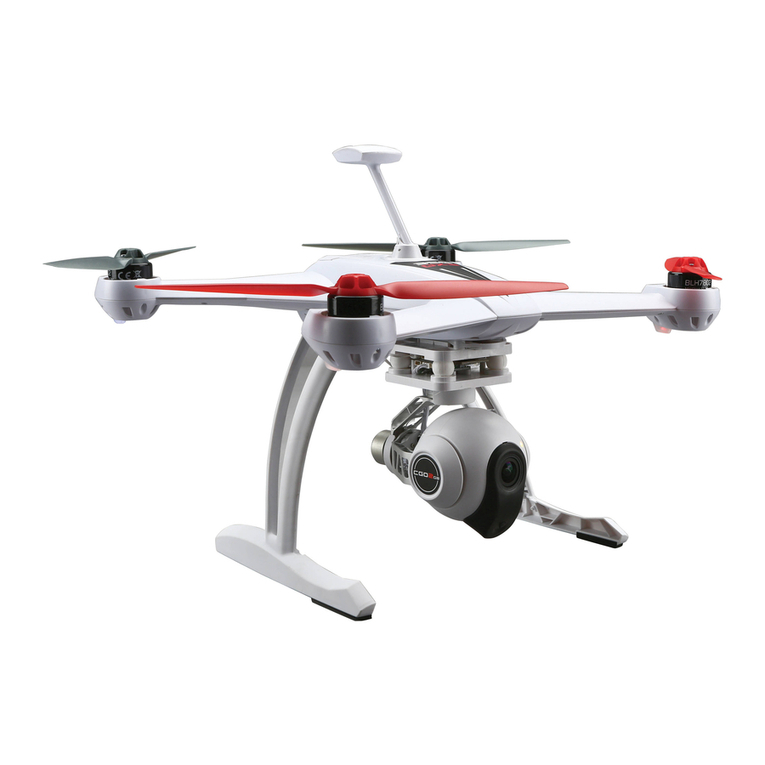
Blade
Blade 350 QX3 User manual
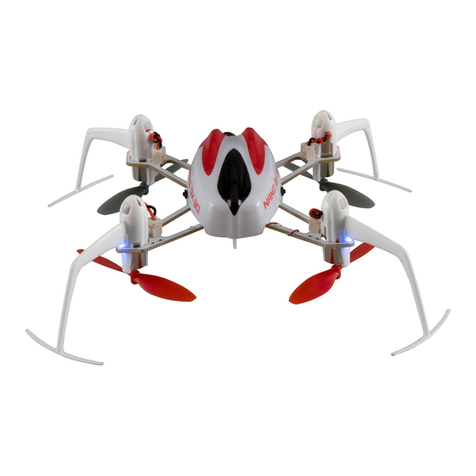
Blade
Blade NANO QX 3d User manual

Blade
Blade 350 QX3 User manual
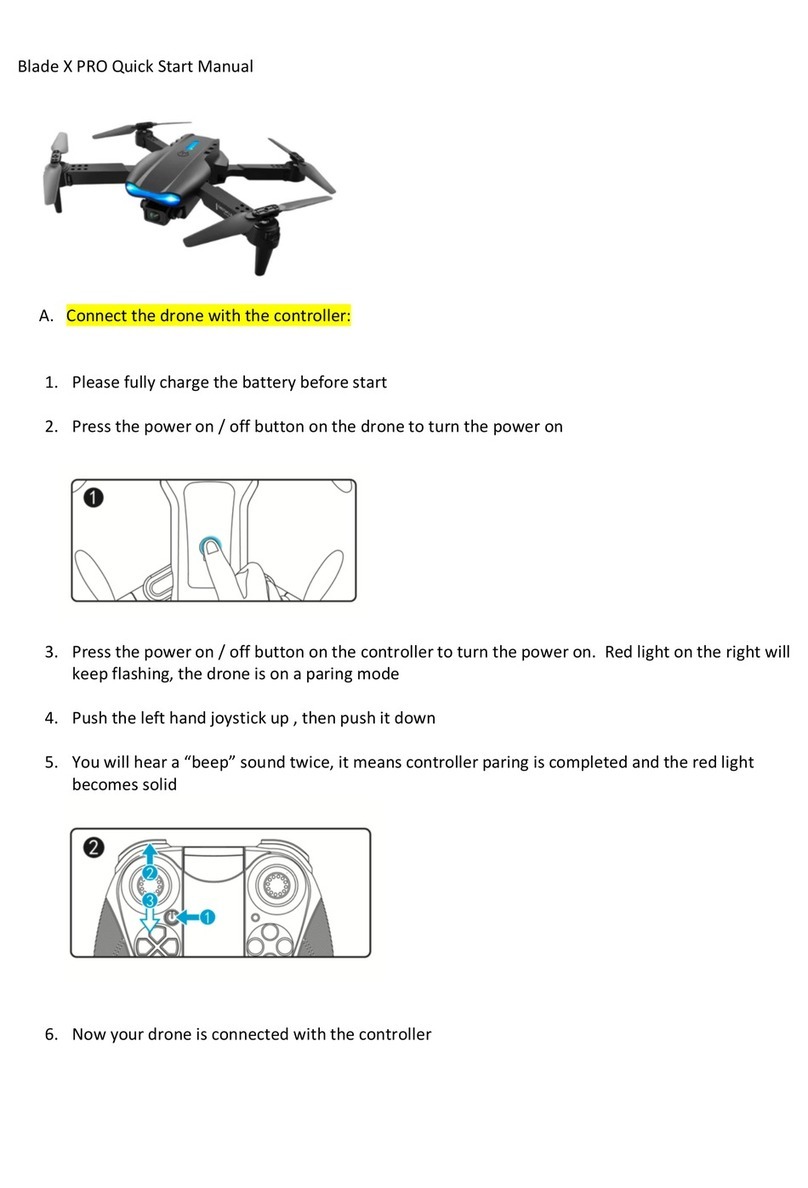
Blade
Blade X PRO Instruction manual
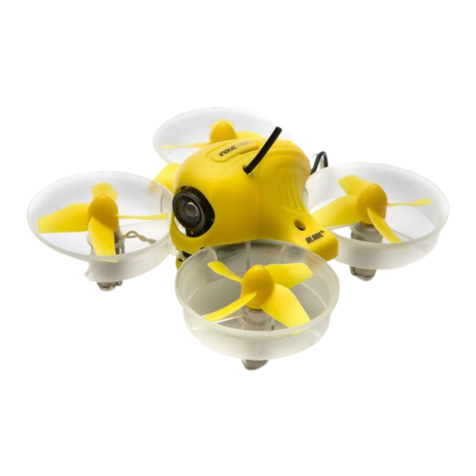
Blade
Blade BLH8500 User manual
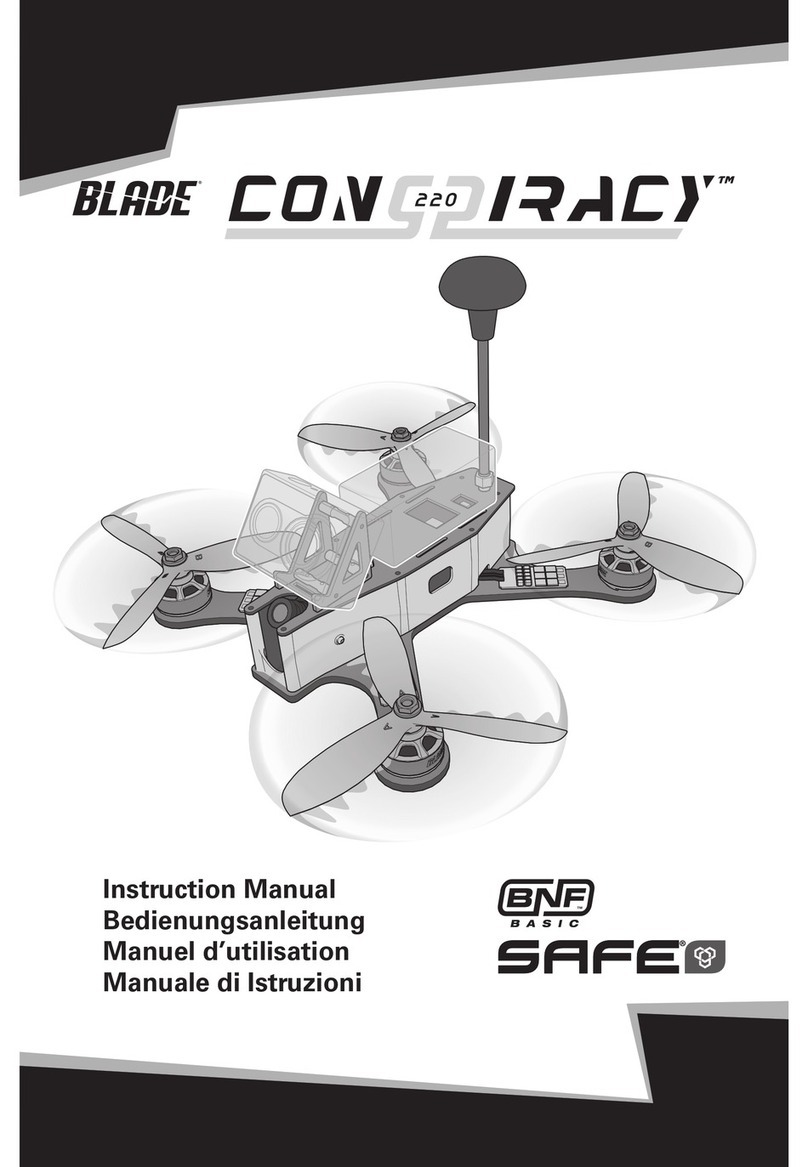
Blade
Blade BLH02000 User manual
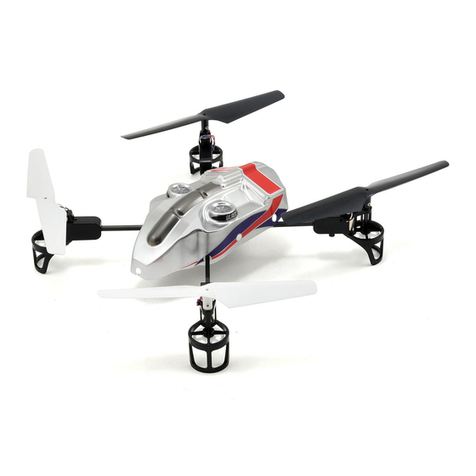
Blade
Blade mQX User manual

Blade
Blade INDUCTRIX FPV Pro BNF User manual
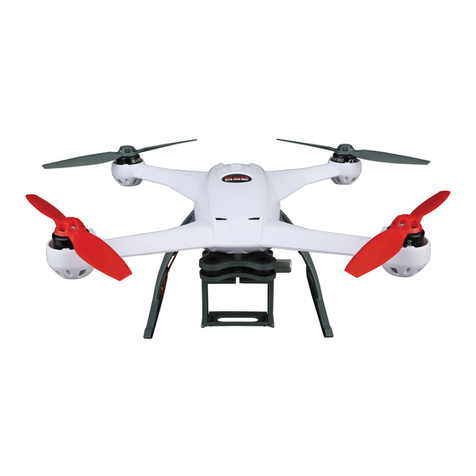
Blade
Blade 350 QX2 User manual

Blade
Blade Blade 180QX HD User manual
